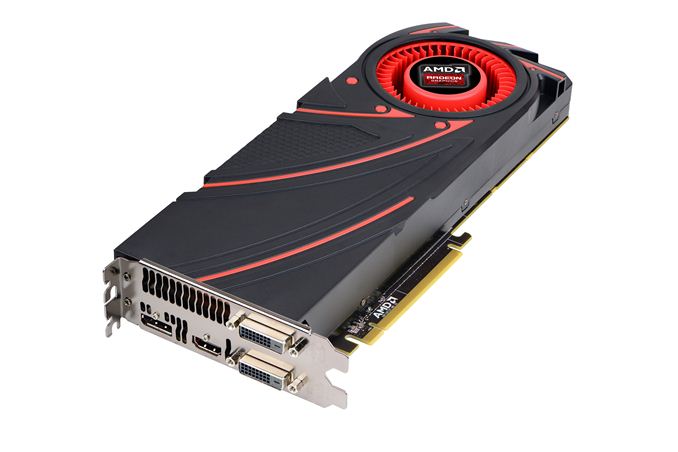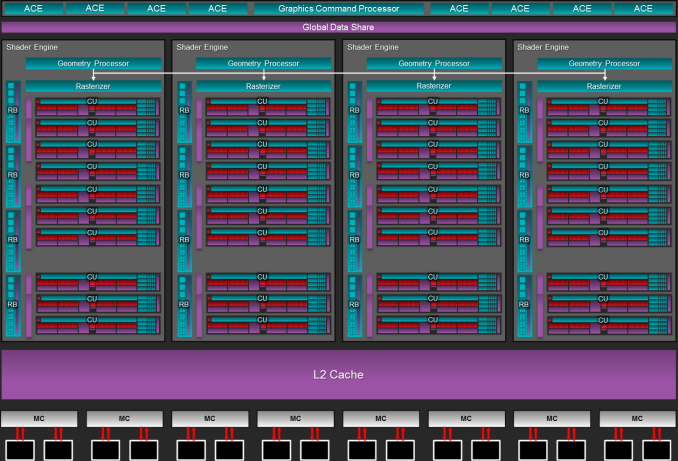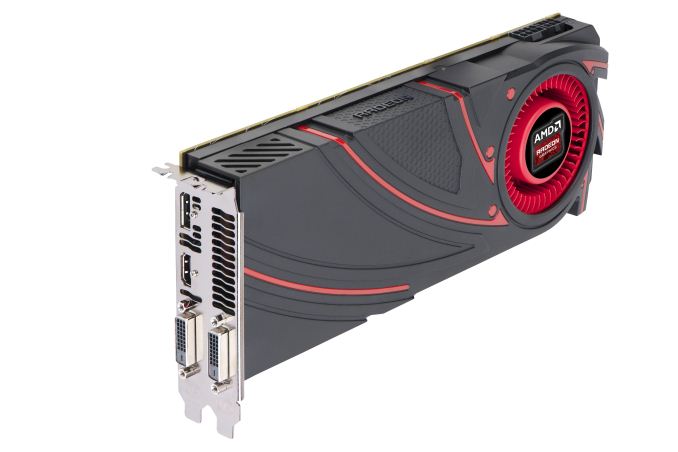The AMD Radeon R9 290 Review
by Ryan Smith on November 5, 2013 12:01 AM EST- Posted in
- GPUs
- AMD
- Radeon
- Hawaii
- Radeon 200

With the launch of AMD’s Radeon R9 290X less than 2 weeks ago, the video card marketplace has become very active very quickly. The 290X not only reasserted AMD’s right to fight for the video card performance crown, but in doing so it has triggered an avalanche of pricing and positioning changes that have affected both NVIDIA and AMD.
NVIDIA for their part cut the price of the GTX 780 and GTX 770 to $500 and $330 respectively, repositioning the cards and giving them their first official price cuts since their spring launches. Meanwhile AMD has also made some changes, and although 290X is unaffected for the moment, 290 was affected before it even launched, receiving an arguably significant specification adjustment. Consequently with GTX 780’s price cut being NVIDIA’s counter to 290X, 290 has gone from just being a lower tier Hawaii card to also being AMD’s counter-counter, and in the process has become a somewhat different card than what it was going to be just one week ago.
But before we get ahead of ourselves, let’s start at the beginning. With the successful launch of the 290X behind them, and the equally successful launch of their new flagship GPU Hawaii, AMD is ready to make their next move. Launching today will be the Radeon R9 290, the obligatory lower-tier part for AMD’s new flagship lineup. Making the usual tradeoffs for a lower-tier part, AMD is cutting down on both the number of functional units and the clockspeeds, the typical methods for die harvesting, in exchange for a lower price. Now officially AMD has not announced the Radeon R9 290 in advance, but with listings for it having already gone up on the same day as the 290X, it’s something that everyone has been expecting.
As always we’ll offer a full breakdown of performance and other attributes in the following pages, but before we even begin with that we want to point out that the 290 is going to be one of AMD’s most controversial and/or hotly debated launches in at least a couple of years. The merits of 290X were already hotly debated in some gaming circles for its noise relative to its performance and competition, and unfortunately 290 is going to be significantly worse in that respect. We’ll have a full rundown in the following pages, but in a nutshell AMD has thrown caution into the wind in the name of maximizing performance.
| AMD GPU Specification Comparison | ||||||
| AMD Radeon R9 290X | AMD Radeon R9 290 | AMD Radeon R9 280X | AMD Radeon HD 7970 | |||
| Stream Processors | 2816 | 2560 | 2048 | 2048 | ||
| Texture Units | 176 | 160 | 128 | 128 | ||
| ROPs | 64 | 64 | 32 | 32 | ||
| Core Clock | 727MHz | 662MHz | 850MHz | 925MHz | ||
| Boost Clock | 1000MHz | 947MHz | 1000MHz | N/A | ||
| Memory Clock | 5GHz GDDR5 | 5GHz GDDR5 | 6GHz GDDR5 | 5.5GHz GDDR5 | ||
| Memory Bus Width | 512-bit | 512-bit | 384-bit | 384-bit | ||
| VRAM | 4GB | 4GB | 3GB | 3GB | ||
| FP64 | 1/8 | 1/8 | 1/4 | 1/4 | ||
| TrueAudio | Y | Y | N | N | ||
| Transistor Count | 6.2B | 6.2B | 4.31B | 4.31B | ||
| Typical Board Power | ~300W (Unofficial) | ~300W (Unofficial) | 250W | 250W | ||
| Manufacturing Process | TSMC 28nm | TSMC 28nm | TSMC 28nm | TSMC 28nm | ||
| Architecture | GCN 1.1 | GCN 1.1 | GCN 1.0 | GCN 1.0 | ||
| GPU | Hawaii | Hawaii | Tahiti | Tahiti | ||
| Launch Date | 10/24/13 | 11/05/13 | 10/11/13 | 12/28/11 | ||
| Launch Price | $549 | $399 | $299 | $549 | ||
Diving right into the hardware specifications, Radeon R9 290 is a bit more powerful than usual for a lower-tier part. AMD has cut the number of CUs from 44 to 40 – disabling 1 CU per SE – while adjusting down the base GPU clockspeed and boost GPU clockspeed to from 727MHz and 1000MHz to 662MHz and 947MHz respectively. However AMD has not cut the amount of memory, the memory clockspeed, the memory bus width, or the number of ROPs, leaving those at 5GHz for the memory clockspeed, 512-bits for the memory bus width, and all 64 ROPs for the back-end hardware.
As a result the differences between the 290 and 290X are on paper limited entirely to the clockspeed differences and the reduced number of CUs. At their top boost bins this gives 290 95% the clockspeed of 290X, and 91% of the shader hardware, giving 290 100% of 290X’s memory performance, 95% of 290X’s ROP and geometry performance, and 86% of 290X’s shading/texturing performance.
Compared to AMD’s last generation offerings, the 290 is going to be closer to 290X than 7950 was to 7970. 290 retains a larger percentage of 290X’s shader and ROP performance, never mind the fact that the full 320GB/sec of memory bandwidth is being retained. As such despite the wider price difference this time around, performance on paper is going to be notably closer. Paper will of course be the key word here, as in the case of 290 more so than any other card we’ve looked at in recent history theory and practice will not line up. Compared to the 290X, practice will be favoring the 290 by far.
Moving on to power consumption, perhaps because of AMD’s more aggressive specifications for their lower-tier card this time around, power consumption is not dropping at all. AMD is still not throwing us any useful hard numbers, but based on our performance data we estimate the 290 to have a nearly identical TDP to the 290X, leading us to keep it at an unofficial 300W. Lower-tier parts typically trade performance for power consumption, but that will not be the case here. Power consumption will be identical while performance will be down, so efficiency will be slipping and 290 will have all the same power/cooling requirements as 290X.
Meanwhile like the 290X launch, the 290 launch is going to be a hard launch, and a full reference launch at that. As such we’ll be seeing 290 cards go up for sale at the usual retailers today, with all of those cards using AMD’s reference cooler and reference board, itself unchanged from the 290X.
As for pricing and competitive positioning, AMD will be launching the 290 at what we consider to be a very aggressive price of $399. Based on the initial specifications, the performance, and the competition, we had been expecting AMD to launch this at $449, mirroring the launch of the 7950 in the process. But AMD has gone one step further by significantly undercutting both themselves and NVIDIA.
290’s immediate competition on the AMD side will be the $549 290X above it and the $299 280X below it, while on the NVIDIA side the competition will be the $499 GTX 780 above it and the $329 GTX 770 below it. Pricing wise this puts 290 as closer competition to 280X/GTX 770 than it does the high-tier cards, but as we’ll see in our benchmarks AMD is aiming for the top with regards to performance, which will make price/performance comparisons both interesting and frustrating at the same time.
NVIDIA for their part will have their 3 game Holiday GeForce Bundle on the GTX 780 and GTX 770, presenting the same wildcard factor for overall value that we saw with the 290X launch. As always, the value of bundles are ultimately up to the buyer, especially in this case since we’re looking at a rather significant $100 price gap between the 290 and the GTX 780.
| Fall 2013 GPU Pricing Comparison | |||||
| AMD | Price | NVIDIA | |||
| Radeon R9 290X | $550 | ||||
| $500 | GeForce GTX 780 | ||||
| Radeon R9 290 | $400 | ||||
| $330 | GeForce GTX 770 | ||||
| Radeon R9 280X | $300 | ||||
| $250 | GeForce GTX 760 | ||||
| Radeon R9 270X | $200 | ||||
| $180 | GeForce GTX 660 | ||||
| $150 | GeForce GTX 650 Ti Boost | ||||
| Radeon R7 260X | $140 | ||||












295 Comments
View All Comments
Sunburn74 - Tuesday, November 5, 2013 - link
Too hot and too loud for any activity other than gaming on a headset. Maybe aftermarket coolers will salvage this card.megalee - Tuesday, November 5, 2013 - link
Well, I have the headphones on while gaming so I don't care about the noise. Sounds like a good deal to me. Good to see some competition!asphix - Tuesday, November 5, 2013 - link
1st -- to anyone claiming that after market coolers will solve the heat/noise issue... you are correct.. but it will come at a cost. Say hello to a $450-$500 R9 290. Only time will tell, but my guess is they will either be mediocre solutions to keep the price down, or expensive (as will need to be to deal with that kind of dissipation).2nd -- AMD has one goal and only one goal with these extreme price points and that's to get themselves out of this catch 22 situation with mantle. In order for developers to program for mantle, there needs to be a user base. The user base will grow if there is mantle. Release cards that are relatively cheap with steep trade-offs to grow userbase. I feel the next release cycle will have more expensive cards with less trade-offs (noise/heat) and even better performance. It all depends on if mantle takes off which depends on people purchasing these cards.
I love the competition! I really dislike these sacrifices AMD are making to compete with Nvidia. However, i understand why the're doing it the way they are and I hope they're successful with it.
haukionkannel - Tuesday, November 5, 2013 - link
If you compare the price of reference 7970 and aftermarket cooler version of 7970, the difference is 10-50$ Nothing too bad... This just shows how bad this AMD reference is... ingredible!http://www.tomshardware.com/reviews/radeon-r9-290-...
But we vary, there may be something fishy with AMD press cards! It may be that retail makers are making even worse job with reference cooler, but now it is time to wait some good aftermarket cooler cards!
MarkcusD - Tuesday, November 5, 2013 - link
"290 is essentially twice as loud as the GTX 780"Lol. What a POS. Seriously it may improve with some non-stock coolers, but I wouldn't touch this card.
willis936 - Tuesday, November 5, 2013 - link
If you convert to linear sound levels it's actually three times as loud. That's mostly academic though.supamark - Tuesday, November 5, 2013 - link
Actually, it's just short of 10 times as loud - it's a log scale.jonjonjonj - Tuesday, November 5, 2013 - link
i get that anand cant recommend the card because of the noise. but i think amd is going to sell a lot of these cards because in the end its all about performance and price. plus who buys a reference card anyway? on the asus cards i have owned you can turn the fan to 100% and its silent. some 3rd party card will come out with a quiet cooler that also unleashes the 290.superjim - Tuesday, November 5, 2013 - link
Wait for OEMs to get out their custom cards with the quiet/cooler open air fans and the 290 will be near perfect at $400.jb14 - Tuesday, November 5, 2013 - link
This card is like a drag race car. Pedal flat to the floor, screamingly loud, burning through petrol, pretty cheap (50W increase - crazy)! The only good thing here is the price/performance shaking things up alittle. NV could also quite happily dump an extra 50W through their cards and we could have to two screaming cards next to each other!I have an AMD card in my laptop but wouldn't consider touching this card in the desktop unless it had some seriously beefed up non-custom coolers. Let's see what the AMD partners can do to try and tame this beast!